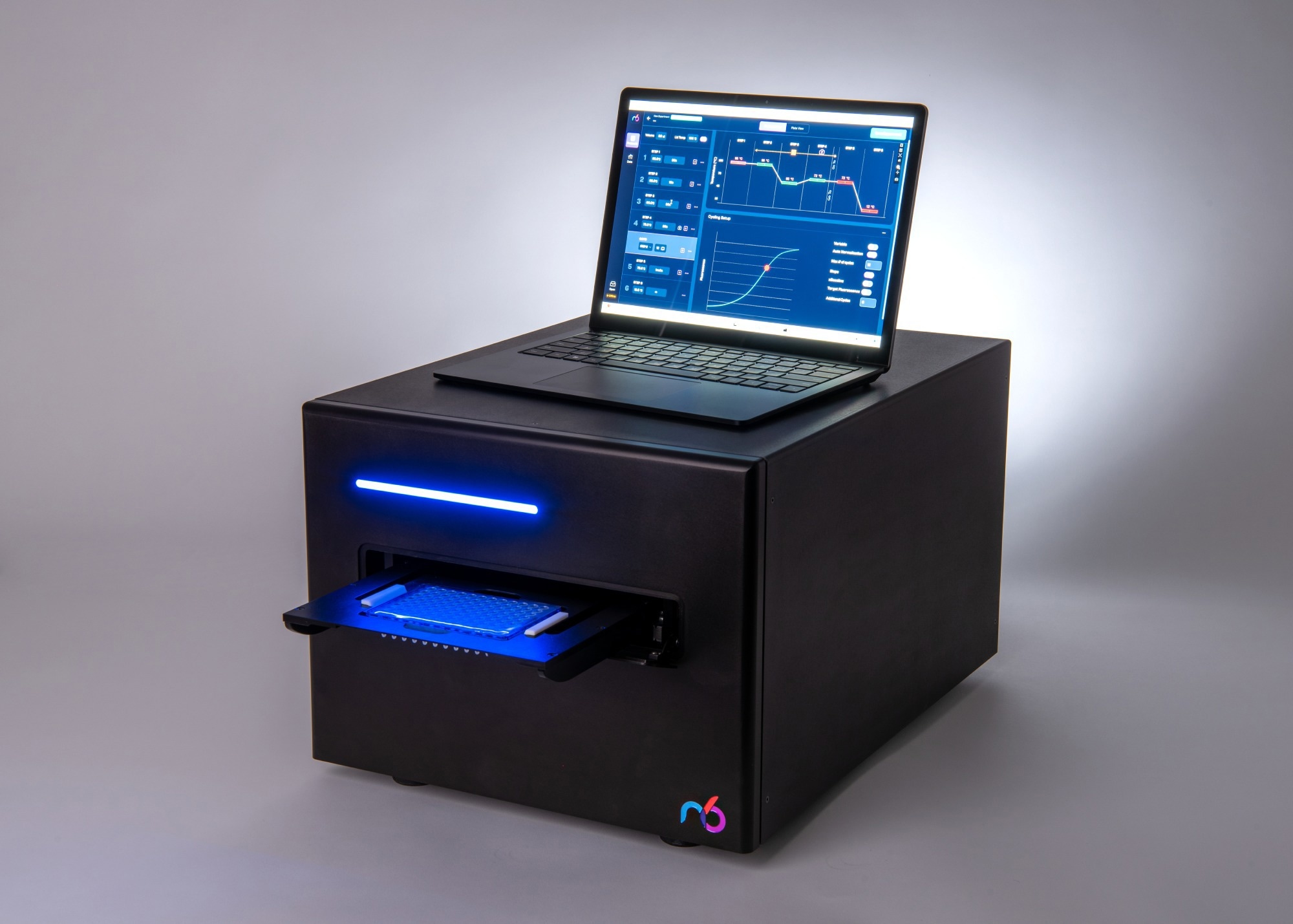In this interview, the team at n6 discusses their groundbreaking iconPCR thermocycler and its impact on laboratory automation, NGS data quality, and real-time control in life sciences, all live from SLAS 2025.
To start us off, can you give an overview of n6 and your mission within the life sciences instrumentation space?
At n6, our mission is simple but ambitious: we’re here to deliver the smarter, scalable tools genomics has always needed—but never had. After two decades of grappling with the limitations of legacy systems, our team set out to fundamentally rethink how labs prepare and process DNA for next-generation sequencing (NGS). Our goal? To enable every lab to generate cleaner, faster, and more cost-effective data at scale—because better tools mean better science, and the future depends on it. We’re obsessed with data quality, scientific integrity, and building solutions that actually solve real-world problems for researchers, not just theoretical ones.

Image Credit: n6
What inspired the development of iconPCR, and how does this innovation address limitations in traditional thermocycling technology?
iconPCR was born out of sheer frustration with the status quo. For years, our founder and team saw the same problems repeat: over-amplified libraries, wasted sequencing runs, and massive variability—all driven by outdated tools that simply weren’t built for today’s scale or complexity. Traditional thermocyclers treat every sample the same, leading to “one-size-fits-none” results. We knew there had to be a better way.
So, we built iconPCR™—the world’s first real-time thermocycler with 96 independently controlled wells. This means every sample gets its own optimal amplification profile, in real time, with no more over- or under-cycling. It’s like giving every sample its own personal trainer, instead of making everyone run the same marathon pace.
With iconPCR being the first of its kind, what technical challenges did the development team face in achieving independent thermal control across 96 wells, and how were they overcome?
The main challenge was engineering 96 fully isolated thermal zones, each with its own heating element and probe, all packed into a compact benchtop instrument. We adapted technologies from the semiconductor and telecom industries, where precision and speed are paramount, and applied them to genomics for the first time. The result: each well is independently programmable, allowing for exact protocol matching per sample, regardless of input amount or assay type. This was no small feat, but it’s what enables the real magic of iconPCR—and what sets it apart from every other thermocycler on the market.
How does AutoNorm™ redefine the standard PCR workflow, and what specific benefits does it bring to researchers working on library preparation and quantification?
AutoNorm™ is the “Goldilocks” of NGS library normalization—making sure every sample is “just right.” Instead of the labor-intensive, error-prone process of purifying, quantifying, and adjusting each sample by hand, AutoNorm monitors DNA synthesis in real time for each well. When a sample reaches the desired endpoint, that well stops cycling—no more, no less.
Benefits for researchers:
- No more manual quantification or normalization steps—just pool, purify, and go.
- Consistent, sequencing-ready libraries every time, with dramatically reduced risk of over- or under-amplification.
- Fewer failed runs, less wasted sequencing, and more reliable data—even for tricky samples like FFPE or low-input RNA.
In terms of data quality and reproducibility, how does iconPCR compare to conventional real-time PCR systems in both research and diagnostic settings?
iconPCR takes data quality and reproducibility to a new level. Traditional real-time PCR systems are batch-based and blind to individual sample needs, often leading to variable results and wasted sequencing. iconPCR’s real-time, per-well feedback ensures that each sample is amplified optimally, preserving true biological signals and minimizing artifacts.
- Higher consistency across samples: No more “problem children” in your 96-well plate.
- High-fidelity data: Fewer PCR duplicates, less bias, and more accurate representation of your samples.
- Better outcomes for challenging inputs: iconPCR shines with degraded, low-input, or high-diversity samples—delivering reliable results where legacy systems often fail.
While iconPCR is CE-marked for research use and not FDA-cleared for diagnostics in the US, it’s already making a difference in translational and preclinical research settings.
Looking ahead, how do you envision the iconPCR platform evolving, and what potential applications or user communities are you most excited to support?
We see iconPCR as the foundation for a new era of intelligent, automated NGS library prep. As genomics continues to scale—from clinical research to agriculture, synthetic biology, and beyond—the need for smarter, more adaptive tools will only grow.
- Exciting applications: Single-cell genomics, spatial transcriptomics, high-throughput core labs, and any workflow where data quality and efficiency matter.
- User communities: We’re especially excited to support labs tackling the toughest samples—metagenomics, FFPE, cfRNA—and those looking to scale up without sacrificing quality or burning out their staff.
How valuable is SLAS as an event for connecting with both industry leaders and end-users, and what kind of feedback do you typically gather from the conference that informs your innovation pipeline?
SLAS is where the future of lab automation and life sciences comes to life. For us, it’s an invaluable opportunity to connect with both industry leaders and hands-on end-users. The feedback we gather is pure gold: real-world pain points, wish lists, and creative ideas that inform our product roadmap. We hear what’s working, what’s not, and what labs wish they could do if only the tools existed.
And this year, we were especially thrilled to be recognized as a 2025 SLAS New Product Award winner for iconPCR at the US conference—it’s not every day your benchtop instrument gets crowned as one of the most innovative technologies in the field!
What’s the one takeaway you hope researchers and automation engineers walk away with after engaging with your team at SLAS 2025?
Don’t settle for “good enough” when you can have “just right.” iconPCR and AutoNorm aren’t just incremental improvements—they’re a fundamental rethink of how NGS library prep should work. If you want cleaner data, faster workflows, and fewer headaches, it’s time to upgrade your tools. We’re here to help you amplify, quantify, and normalize—all at once, with no compromises.
Finally, what’s next for n6? Is there anything new you’re excited to work on?
Our team is already hard at work on new software features, expanded assay compatibility, and deeper automation. We’re also exploring partnerships with leading research centers and industry innovators to push the boundaries of what’s possible in genomics. Stay tuned for more breakthroughs—and if you have a workflow challenge, bring it to us. We love a good puzzle!
Where can readers find more information?
For the latest on iconPCR, AutoNorm, and all things n6, visit our website (https://www.n6tec.com/) or contact our team directly (https://www.n6tec.com/#contact-us). We’re always happy to share resources, success stories, and a little bit of our “Goldilocks” approach to genomics.
About the Interviewee
Dr. Yann Jouvenot, Sr. Director of Product at n6 is one of the initial members of the n6 team. With 20+ years of experience in biotech and molecular diagnostics, Yann has been helping lead the product development of iconPCR, including its performance in specific applications such as metagenomics.
performance in specific applications such as metagenomics.